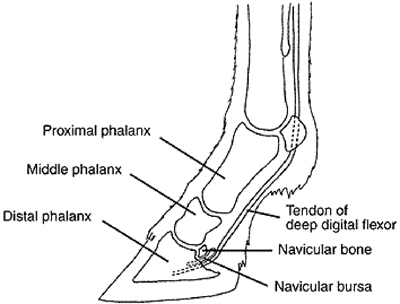Navicular Disease
Navicular disease is lameness of the front feet caused by an injury or inflammation to the navicular bone which is part of the coffin joint in a horses foot.
The condition has been recognized for well over 200 years but there is still no single effective treatment.
The navicular bone is a small bone at the back of the foot, about 5 cm in from the middle of the frog.
It serves as a pulley for the flexor tendon.
It helps maintain a constant angle of attachment for the deep flexor tendon which connects the foot to one the biggest muscles in the horse.
It also acts as a valve for blood flow to the coffin bone and corium inside the hoof.
This means that the navicular bone takes a real beating during heavy exercise or if the horse has to work on hard surfaces.
Hard surfaces such as pavement cause jarring to the bones.
In between the navicular bone and the tendon is a fluid filled sac called the navicular bursa.
The fluid provides a smooth slide of the tendon over the bone.
Navicular syndrome arises from a degeneration of the bursa, the bone and the flexor tendon. The sliding movement becomes more difficult.
Factors Leading to Navicular
Circulation problems
The conformations of the horse
Inherited disposition to the disease
Racing, cutting and roping horses have a higher incidence of navicular disease than pleasure horses.

Diagnosis
Navicular disease is a gradual and progressive increase in lameness of the front legs. So gradual that by the time it is diagnosed it usually has progressed to an advanced state.
Signs to look for:
Shortening of the stride
A continual shifting of body weight when resting
A stumbling gait
Slight unevenness on turns
Reluctance to go forward properly or lengthen the stride
Pointing - the horse will stand at rest with one leg extended, the weight resting on the toe
When the foot is pressure tested, the horse will usually indicate heel pain
Irritability
Hoof becomes smaller and contracted
A horse with navicular disease tends to place its weight on the toe while walking to avoid placing pressure on the heel area, which contains the inflamed navicular bone and bursa. Since the horse does not place weight on the heel, it takes longer to stop the stride. While standing the horse tends to shift its weight continuously. This relieves pressure, and thus pain, on the heel areas. Since the horse tends to place its weight on the toes during movement, the gait is very rough and sometimes gives the appearance of lameness in the shoulder. The horse is often lame after work, but the lameness may disappear with rest. Because there may be comparably poor circulation in the foot, the heels and adjacent hoof may become smaller and contract because there may be comparably poor circulation in the foot, the heels and adjacent hoof may become smaller and contract
Treating Navicular
Treatments for navicular disease have included drugs such as Isoxuprine (Circulon®)This drug dilates the small peripheral blood vessels, thereby improving circulation.
Treatment of giving a pain reliever such as Bute, although there is the danger of bone fracture and of deep digital flexor tendon rupture if pain relief remedies are given for the pain because it allows the horse to put more pressure on the leg.
Gallium nitrate treatment:
Gallium nitrate is the newest and least tested chemical therapy. It sounds very interesting.
"According to Raymond P. Warrell, Jr., M.D., of the Memorial Sloan Kettering Cancer Center in New York City, elemental gallium and its various compounds are potent inhibitors of bone resorption that act to maintain and restore bone mass in all vertebrate species."
Acupuncture and magnet therapy is open to speculation but many people say it is helpful.
The treatment of cutting the nerve (neurectomy) supplying sensation the heels of the foot can also cause bone fracture. If a neurectomy is performed, the horse should be put out to pasture.
A new surgical treatment which involves cutting the navicular suspensory ligament will result in long term improvement (3 years) in about 40% horses.
A horse with navicular disease must have correct trimming and balancing of the foot. In many cases there is improvement of the problem with correct shoeing and trimming.
Diagnosing Navicular syndrome
A locally injected anesthetic that temporarily blocks the nerve supply to the affected area will relieve the pain for a short period of time.
In this way the veterinarian can determine whether or not navicular disease exists.
If the horse was lame before the injection, and walks normally after the injection, it may be assumed that the lameness is located in the navicular area.
Preventing Navicular syndrome
Do not keep the horse confined or stall-kept
Exercise the horse consistently
Horses with strong physical demands placed on them inconsistently might develop the disease
Keep the horse from becoming overweight since the pressure of their weight on the hoofs can cause problems.
Horses with small feet such as thoroughbred and quarter horse can develop this disease
If the hooves are not properly cared for, the navicular bone becomes immobile, resulting in poor blood flow within the hoof.
Move From Navicular Disease Back To Equine Health.
Move Back To Living With Horses Home Page
Products
|
|
|

